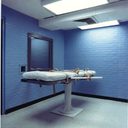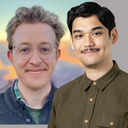
A six-day federal trial on the constitutionality of Oklahoma’s lethal-injection protocol has concluded, with medical experts for the state’s death-row prisoners citing autopsy and eyewitness evidence to call the process “torturous” and doctors for the state denying that prisoners suffered as they were being put to death.
The evidentiary portion of the trial began with medical testimony for the prisoners on February 28, 2022 and concluded with closing arguments from the two sides on March 7. The prisoners presented graphic photographic evidence from the botched execution of John Grant, autopsy results showing that Grant and fellow death-row prisoner Bigler Stouffer suffered fluid build-ups in their lungs as they were put to death, and autopsy evidence that Grant aspirated vomit during his execution.
The trial also featured blockbuster documentary evidence that members of Oklahoma’s execution team filled out paperwork indicating the state had used an unauthorized chemical in place of the paralytic drug required in the state’s execution protocol. The state’s chief corrections official denied that there had been a drug mix-up, describing the appearance of the wrong chemical in state execution records as “a transcription error.” And the trial court permitted prosecutors to present anonymous testimony, submitted in writing, from a state doctor who was not subject to cross-examination by the prisoners’ lawyers.
U.S. District Court Judge Stephen Friot (pictured) now must weigh the medical evidence and the conflicting testimony of experts presented by the state and the prisoners, and rule on whether the state’s three-drug execution protocol constitutes cruel and unusual punishment. His decision is expected to take several months.
The Prisoners’ Evidence at the Trial
The death-row prisoners’ case opened with testimony from Dr. Craig Stevens, a professor of pharmacology at Oklahoma State University. Dr. Stevens provided testimony that midazolam, the first drug in Oklahoma’s execution protocol, lacks the pharmacological properties necessary to adequately render prisoners unconscious and insensate before they are paralyzed by the second drug, vecuronium bromide, and subjected to what he called the “burning fire” sensation of the third drug, potassium chloride.
Dr. Mark Edgar, a pathologist and autopsy director at the Mayo Clinic in Florida, who reviewed more than 30 autopsies of prisoners executed by death penalty protocols that employed midazolam, testified that 27 of those prisoners experienced “severe pulmonary edema,” or fluid filling the lungs. He described the sensations of pulmonary edema as “doom, panic, drowning, and asphyxiation.” Edgar attributed the edema to the use of midazolam. Reviewing the two available autopsy reports from the Oklahoma executions conducted while the trial was pending, Dr. Edgar testified that both Grant and Stouffer had experienced pulmonary edema. The average weight of an adult male’s lungs is 1,000 grams. Stouffer’s autopsy report noted that his lungs, heavy with fluid, weighed 1510 grams. Grant’s autopsy placed the weight of his lungs at 1390 grams.
Another phenomenon noted in the midazolam autopsies Dr. Edgar studied was froth in the executed prisoners’ lungs. Images of Grant’s lungs shown to the court contained what appeared as bubbles — evidence of frothing — which, Edgar testified, could only occur if “the prisoner is alive and breathing” when the edema occurred.
The prisoners also presented testimony from an anesthesiologist, Dr. Gail Van Norman, who testified to a “virtual medical certainty” that the four prisoners executed in 2021 and 2022 under Oklahoma’s current protocol “experienced extreme pain and suffering.” An Oklahoma Department of Corrections (ODOC) document from Gilbert Postelle’s February 17, 2022 execution that was introduced into evidence during her testimony indicated that the state used an unauthorized drug, “rocuronium,” as the paralytic drug in the execution, rather than vecuronium bromide, the drug required in the state’s protocol. Records ultimately introduced at the trial indicated that rocuronium bromide was listed on documents relating to three of the four executions.
ODOC Director Scott Crow later testified that this was a transcription error and assured the court that the correct drug had been used. The incident was reminiscent of the state’s previous violations of its execution protocol, which included purchasing and using the wrong drug in the execution of Charles Warner. Oklahoma halted executions in 2015 after calling off Richard Glossip’s execution at the last moment after corrections personnel discovered that they had obtained the same wrong drug. “I was not at all happy about that,” Crow said about the mislabeling.
In 2015, the U.S. Supreme Court ruled in Glossip v. Gross that a prisoner must prove that a less painful alternative method of execution is available to the state before a court may declare the state’s chosen method unconstitutional. To meet that requirement, the prisoners also presented evidence related to alternative execution methods. Dr. David Sherman, a professor of medical chemistry at the University of Michigan, testified that anesthetics like pentobarbital and sodium thiopental could be produced easily and cheaply within the state of Oklahoma. “It’s easy to construct and can be done on a large scale,” Sherman said. “This could be done by undergraduate students with experience in organic chemistry.”
Dr. James Williams, a firearms expert and emergency medicine doctor, testified regarding the use of firing squad as an alternative method. “Execution by firing squad is feasible, practical and efficacious,” Williams said. He said that, if a prisoner’s heart were targeted by executioners using a 30-caliber service rifle, the prisoner would be “almost immediately unconscious” after being shot. Eighteen of the prisoners involved in the lawsuit selected firing squad as an alternative method of execution.
Oklahoma’s Evidence
Witnesses for the state included Dr. Ervin Yen, an anesthesiologist and former Republican state senator who is running for governor; an anonymous doctor who is being paid $15,000 per execution for his participation in putting Oklahoma prisoners to death; and Oklahoma corrections officials.
Dr. Yen called the protocol “adequate to carry out an execution in as humane a way as possible.” Oklahoma Department of Corrections Director Scott Crow and Chief of Operations Justin Farris also testified in support of the protocol. Farris told the court that he had attended each of the state’s four recent executions and the prisoner appeared to him to be unconscious immediately after midazolam was administered. He contested Dr. Sherman’s testimony that pentobarbital and sodium thiopental are readily available, saying that the state had tried to obtain those drugs but could not find a company willing to provide either of them. Labs in the state were also unwilling to produce them, Farris said.
Over objections by the prisoners’ counsel, Oklahoma prosecutors were permitted to present written testimony by the doctor who has participated in the last four executions. The prisoners argued that the arrangement denied them the right to question the doctor, and that his identity could remain hidden and their right to cross examine could be preserved if the doctor testified remotely by telephone or Zoom with a voice modulator and the video turned off. Prosecutors responded, without evidence, that the doctor faced potential professional or physical harm if “anti-death penalty activists” discovered his identity.
Using the pseudonym “Dr. John Doe” to conceal his identity, the doctor explained the process by which he conducted consciousness checks. First, Dr. Doe wrote, he rubs the prisoner’s sternum, then speaks loudly to them, and then squeezes and pinches their arm. Dr. Van Norman disputed the adequacy of Doe’s efforts, testifying that she had timed the sternum rub during Postelle’s execution as taking a mere three seconds and saying that the restraints that held Postelle to the gurney prevented Doe from rubbing Postelle’s sternum in the right place.
Doe’s description of John Grant’s execution appeared to conflict with contemporaneous accounts from media eyewitnesses, who reported that Grant experienced more than two dozen full-body convulsions over a 15-minute period and vomited several times before Doe declared him unconscious. His autopsy indicated that Grant had aspirated vomit. Referring to Grant’s vomiting as “regurgitation,” Doe said, “We turned his head and wiped him off around the mouth. He was unconscious then, in my opinion, based on his lack of reaction or resistance to these physical actions on him.” Doe wrote, “He did not open his eyes, he didn’t do anything to show he was conscious, he didn’t resist anything we did.”
Dr. Doe received $60,000 for his participation in the four executions, plus $1,000 per day for weekly training sessions and execution-week preparation sessions. Oklahoma has said it intends to schedule as many as 28 executions if the lethal-injection protocol is upheld, meaning Doe stands to make $420,000 for his involvement in the executions and at least another $56,000 in payments for training and preparation sessions.
In closing arguments, Jim Stronski, representing the prisoners, told the court, “This is a 21st-century burning at the stake,” referring to the burning sensation caused by the third drug in Oklahoma’s protocol, potassium chloride. Solicitor General Mithun Mansinghani, representing the state, countered, “Midazolam is approved to induce general anesthesia, and general anesthesia means no pain.”
Sean Murphy, Federal judge opens hearing on Oklahoma’s lethal injection, Associated Press, February 28, 2022; Nolan Clay, Will executions continue in Oklahoma? Federal judge to decide after hearing from experts, The Oklahoman, March 1, 2022; Storme Jones, Experts Testify To Fluid In Death Row Inmates’ Lungs In Protocol Trial, KWTV, CBS TV, Oklahoma City, March 1, 2022; Jessica Bruno, Plaintiffs expected to rest their case Wednesday in trial challenging Oklahoma’s execution protocol, KFOR, NBC TV, Oklahoma City, March 1, 2022; Mike Creef, FEDERAL TRIAL FOR OKLAHOMA’S EXECUTION PROTOCOL UNDERWAY, The Black Wall Street Times, March 2, 2022; Nolan Clay, Expert: Oklahoma inmate killed by new lethal injection drugs felt pain, The Oklahoman, March 3, 2022; Nolan Clay, Expert calls executions humane following complaints from Oklahoma death row inmates, The Oklahoman, March 4, 2022; Jessica Bruno, ‘I was not at all happy,’ Oklahoma Dept. of Corrections director testifies about execution transcript error during fifth day of federal trial, KFOR, NBC TV, Oklahoma City, March 4, 2022; Nolan Clay, Under a fake name and in writing, Oklahoma’s execution doctor explains role, The Oklahoman, March 7, 2022; Nolan Clay, Executions in Oklahoma remain on hold until judge rules on constitutionality of method, The Oklahoman, March 7, 2022.



